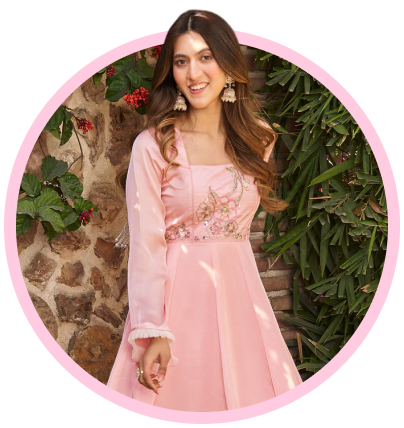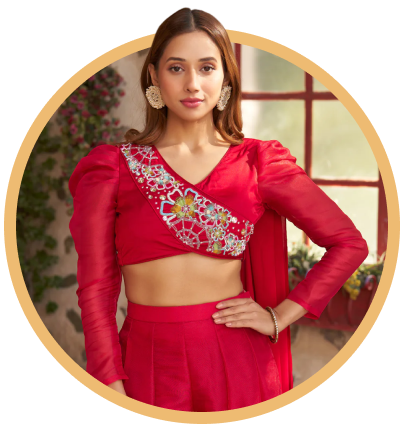
Saree or Lehenga: Which is Best for Weddings?
The choice between a saree or lehenga for a wedding is influenced by personal preferences, traditions, and the vibe you wish to portray. Both are iconic bridal outfits, deeply rooted in Indian culture and admired for their grace and splendor.
1. Lehenga
A lehenga is worn for various pre-wedding events in addition to the wedding. Different lehenga designs, colors, and themes are kept in mind depending on the occasion. You can select from multiple variations of this dress for your BIG day. Some of them are gota Patti lehengas, lehengas with sequin embellishments, lehengas with mirror work, zardozi lehengas, lehengas with ombre patterns, lehengas with contrasting blouses, banarasi lehengas, brocade lehengas, mermaid lehengas, flared lehengas, A-line lehengas, lehengas with Sharara cuts, half-saree lehengas, and other styles.
The bright and bold red lehenga remains a classic favorite, symbolizing love and tradition. Whether it’s a wedding lehenga or a lehenga for wedding party, these ensembles capture the essence of festivity and opulence.
2. Saree
The traditional indian saree wedding dress has been a beloved choice for centuries, known for its elegance and timelessness. Brides from various regions of India often choose specific types of sarees that represent their heritage:
- Banarasi sarees
- Kanjivaram sarees
- Konrad sarees
- Baluchari sarees
- Tussar silk sarees
- Pathani sarees
- Patola sarees
- Jamawar sarees
For South Indian brides, the Kanjivaram saree stands out as the epitome of bridal elegance. Meanwhile, the banarasi saree is favored by brides across North, East, and West India. The intricate detailing and luxurious fabrics of these sarees make them ideal choices for weddings.
When To Wear Bridal Lehenga?
Unquestionably, a lehenga is a timeless bridal outfit that can be worn for any event or function at any time of day. Lehengas work well for a traditional Indian style and a more understated, refined look on your wedding day. The best thing about a lehenga is that you'll never be dissatisfied. But again, everything has advantages and disadvantages.Advantages
- A bridal lehenga is the perfect option for those who wish to dress very traditionally on their wedding day.
- For your wedding, it effortlessly provides you with a regal and opulent appearance.
- The silhouette of bridal lehengas is beautiful and straightforward to wear. Moving into lehengas is simple as well.
- It is simpler to coordinate your lehenga with the groom’s attire. You two can be a deadly duo!
- Everybody looks great in a lehenga, and it fits all body types!
Disadvantages of Lehenga:
-
Weight: Heavily embellished lehengas can be cumbersome to wear for long durations.
- Limited Variations: Although lehengas come in numerous styles, finding the perfect one can sometimes be a challenge.
When To Wear A Bridal Saree?
A saree is a style that flatters every woman's body type and takes elegance to a whole new level. There are numerous benefits to wearing a saree for a wedding dress, making it a popular choice for brides. This silhouette is essentially linked with weddings and offers timeless appeal. While the bridal saree and lehenga both have their unique charm, the saree remains a classic symbol of grace. There are far too many advantages to this outfit, such as versatility and tradition, but there are also some disadvantages to consider.Advantages
- No matter your height or body shape, it is an adaptable outfit that looks great on everyone!
- Your bridal saree for wedding will be your greatest companion in the days after your wedding as you attend other events and formal functions.
- You can match your hair with a saree with any hairstyle possible.
- The bridal saree is your best option if wearing heavy bridal jewelry is your thing. This outfit is gorgeous and quite flattering.
- Sarees are usually an affordable option. Designer sarees for wedding start at just 10,000 rupees!
- Saree for wedding guests is quite a popular option too making it a versatile option for bridesmaid to coordinate with the bride.
- There are many different draping styles available when it comes to sarees.
Disadvantages
- It isn't easy to carry a saree and walk around if you are not used to wearing one.
- You'll need a lot of safety pins, which can be unpleasant, to keep the saree in place.
- Your choices for saree textiles are limited because sarees are easily crushed.
- The saree wrinkles are complicated, and you'll think about them nonstop.
- Matching modern jewelry with a bridal saree can be tricky if you plan to wear it on your wedding day.
Bridal Lehenga and Wedding Saree Online: Making Your Choice
With the rise of e-commerce, finding the perfect bridal indian dress has never been easier. From lightweight gown lehengas to party wear lehenga saree, online stores offer a wide variety of options to suit your preferences and budget.
When choosing between a lehenga and saree, consider factors like your comfort, the cultural traditions of your family, and the overall theme of your wedding. Whether it’s a ghagra for wedding reception or a bridal sarees for wedding, each outfit tells its own story and reflects your personal style.
Final Words:
In conclusion, the decision between bridal lehengas and wedding sarees ultimately comes down to one's personal preferences, sense of style, and the cultural importance they want to embrace on their special day. Both bridal lehengas and wedding sarees retain a special place in brides-to-be hearts since they provide one-of-a-kind and exquisite options to make a dazzling fashion statement. Wedding sarees are a classic option for individuals who want to fully immerse themselves in the rich tapestry of history and symbolism. Their exquisite curtains, dexterous craftsmanship, and regional differences highlight India's rich cultural past. Sarees also have sentimental value from being passed down through families, making them valuable possessions for future generations.
Frequently Asked Questions
Should I choose a saree or lehenga for my wedding?
It depends on your personal preference, cultural traditions, and comfort. A saree is timeless and elegant, while a lehenga offers a regal and modern look.
What is the difference between a lehenga and a saree?
A saree is a single piece of fabric draped elegantly, while a lehenga consists of a skirt, blouse, and dupatta. Lehengas are easier to wear, while sarees are deeply traditional.
Can I reuse my bridal outfit?
Yes! Sarees are versatile and can be reused for various occasions. Lehengas can also be styled differently for parties or festive events.
What is the ideal color for a bridal lehenga?
Red remains a classic choice, but pastel shades, gold, and jewel tones are also popular for modern brides.
Where can I buy bridal lehengas and wedding sarees online?
Many reputable online stores offer a wide range of options, including lehenga saree for wedding and bridal lehenga designs to suit every bride’s taste and budget.











